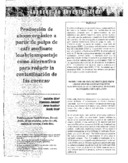Producción de abono orgánico a partir de pulpa de café mediante lombricompostaje como alternativa para reducir la contaminación de las cuencas
ISSN
1022-7482Fecha de publicación
1998Tipo
Artículo
Metadatos
Mostrar el registro completo del ítemDescripción
Ilus. 1 fig. 1 tab. 13 ref. Sum. (En, Es)
Resumen
La pulpa de café genera severos problemas de contaminación en las cuencas de América Central. La lombricultura es una alternativa apropiada para el aprovechamiento de este subproducto que permite mejorar los suelos, generar ingresos adicionales para los productores y contribuir a la sostenibilidad del ecosistema. En esta investigación se probaron tres métodos para preparar lombriabono utilizando pulpa de café: 1) suministro gradual (en capas) del sustrato y retiro total del lombriabono (SGRT), 2) suministro total del sustrato con retiro total del lombriabono (STRT) y 3) suministro total del sustrato con retiro gradual del lombriabono (STRG). Se utilizó pulpa de café con 28 días de descomposición aeróbica y la lombriz roja californiana (Eisenia fetida). El tratamiento SGRT tuvo el porcentaje más alto de transformación de pulpa a lombriabono. El número final de lombrices obtenido con el tratamiento SGRT no fue significativamente diferente del obtenido con el tratamiento STRT. La conversión más rápida de pulpa a lombriabono se obtuvo con los tratamientos SGRT y STRG. Se concluye que el tratamiento SGRT fue el método más eficiente para producir abono orgánico a partir de pulpa de café.
Coffee pulp, which is a sub-product of coffee processing, causes severe problems of contamination in Central American watersheds. Earthworm cultivation is an appropriate technology for using this sub-product to improve soils, generate additional income for coffee producers and contribute to ecosystem sustainability. In the present study, three methods of earthworm compost from coffee pulp were tested: 1) gradual addition (in layers) of substrate and total removal of the earthworm compost (GSOR) 2) total addition of the substrate and total removal of the earthworm compost (OSOR) 3) total addition of the substrate and gradual removal of the earthworm compost (OSGR). Coffee pulp, which had undergone a 28 day period of aerobic decomposition and the California red earthworm, Eisenia fetida, were used in the study. The GSOR resulted in the highest transformation of coffee pulp to earthworm compost. The final number of earthworms in the GSOR treatment was not significantly different than the obtained in the OSOR treatment. The most rapid conversion of coffee pulp to earthworm compost was obtained with the GSOR and OSGR treatments. It was concluded that the GSOR was the most efficient method of producing earthworm compost from coffee pulp.
Palabras clave
Editor
CATIE, Turrialba (Costa Rica)


